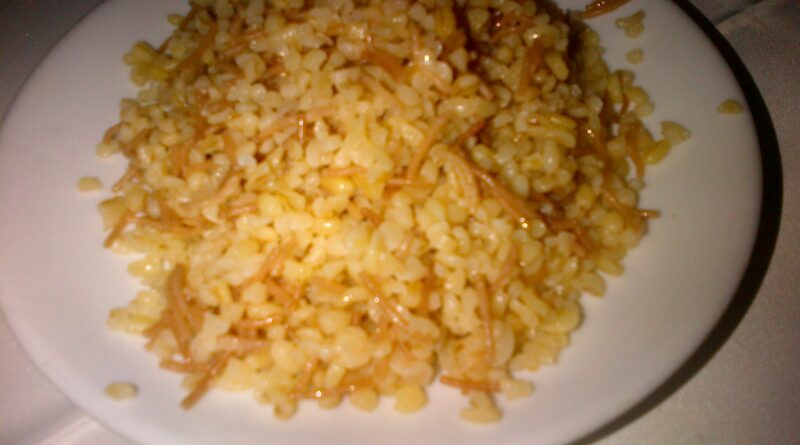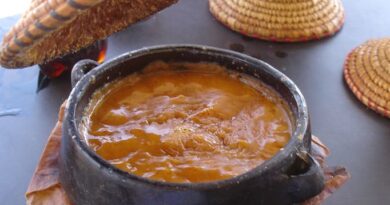Bulgur pilavı (Bulgur rice)
Bulgur Pilavı (Bulgur Rice): A Timeless Taste of Turkish Cuisine
Nestled within the heart of Turkish cuisine lies a dish that embodies simplicity, wholesomeness, and irresistible flavor—Bulgur Pilavı. This classic Turkish pilaf, made from cracked wheat known as bulgur, has been a staple of Turkish meals for centuries. Join us on a journey through the rich history, culinary artistry, and cultural significance of Bulgur Pilavı, and discover how to prepare this timeless Turkish delight in your own kitchen.
The Roots of Bulgur Pilavı
Bulgur Pilavı, often referred to simply as “bulgur pilaf,” is deeply rooted in Turkish culinary traditions. The dish’s history can be traced back to ancient times when the cultivation of wheat was widespread in the region that now encompasses modern-day Turkey. Bulgur, a nutritious whole grain made from cracked wheat, was a dietary staple for generations.
Bulgur: The Heart of the Dish
The key ingredient in Bulgur Pilavı is, of course, bulgur. Bulgur is made by parboiling whole wheat berries, then drying and cracking them into various sizes, from fine to coarse. The degree of cracking determines the cooking time and texture of the bulgur. For pilav, a medium or coarse grind is commonly used, which imparts a satisfying chewiness to the dish.
The Wholesome Ingredients
Bulgur Pilavı, at its core, is a testament to the beauty of simplicity. The dish is composed of a handful of wholesome ingredients that come together harmoniously:
Bulgur
As mentioned, bulgur is the star of the show. Its nutty, earthy flavor and slightly chewy texture make it an ideal base for pilav.
Onion
Onions form the flavor base of Bulgur Pilavı. They are finely chopped and sautéed to develop a sweet, aromatic foundation for the dish.
Tomato Paste
Tomato paste adds depth and richness to the pilaf, lending it a vibrant reddish hue.
Olive Oil
High-quality olive oil is essential for both sautéing the onions and providing a delicate, fruity finish to the pilav.
Hot Water or Broth
Liquid, whether it’s hot water or flavorful broth, is used to cook the bulgur until it becomes tender and absorbs all the wonderful flavors of the other ingredients.
Spices and Seasonings
Common seasonings include ground black pepper and salt, which are used to enhance the overall flavor profile. Some variations may include red pepper flakes for a touch of heat.
Fresh Herbs
Fresh herbs like parsley or mint are typically used as a garnish, providing a burst of color and herbaceous aroma.
Crafting the Perfect Bulgur Pilavı
Preparing Bulgur Pilavı is a delightful endeavor that yields a comforting, flavorful dish. Here’s a step-by-step guide to creating your own batch of this Turkish classic:
Step 1: Sauté the Onions
- Heat a generous amount of olive oil in a large, heavy-bottomed pan.
- Add finely chopped onions and sauté them until they turn translucent and begin to caramelize.
Step 2: Add Tomato Paste
- Stir in tomato paste and continue to cook for a few minutes, allowing it to meld with the onions and develop a rich, deep flavor.
Step 3: Add Bulgur
- Add the bulgur to the pan and toast it for a few minutes, stirring constantly to prevent burning. This step enhances the nutty flavor of the bulgur.
Step 4: Pour in Liquid
- Carefully add hot water or broth to the pan, covering the bulgur by about an inch or so.
- Season with ground black pepper and salt to taste.
Step 5: Simmer and Cover
- Reduce the heat to low, cover the pan with a lid, and let the Bulgur Pilavı simmer. The cooking time will depend on the grind of the bulgur; fine bulgur will cook faster than coarse bulgur.
- Cook until the bulgur absorbs all the liquid and becomes tender, typically 15-20 minutes.
Step 6: Rest and Fluff
- Once the Bulgur Pilavı is cooked, remove it from the heat and let it rest, covered, for a few minutes.
- Fluff the pilav with a fork to separate the grains and ensure an even texture.
Step 7: Garnish and Serve
- Transfer the Bulgur Pilavı to a serving dish.
- Garnish with freshly chopped parsley or mint.
- Serve hot as a side dish or as a main course with your choice of accompaniments, such as yogurt, pickles, or grilled vegetables.
The Cultural Significance of Bulgur Pilavı
Bulgur Pilavı is more than just a dish; it is a reflection of Turkish culture, tradition, and the art of hospitality. This wholesome pilaf has played a significant role in Turkish cuisine for centuries, gracing the tables of homes, restaurants, and special gatherings.
A Staple in Turkish Cuisine
In Turkey, Bulgur Pilavı is a culinary cornerstone. It is a side dish that accompanies a wide range of Turkish meals, from kebabs to stews. Its humble yet hearty nature makes it a comforting addition to any spread.
A Symbol of Generosity
In Turkish culture, food is a symbol of hospitality, and sharing a meal is a gesture of friendship and goodwill. Bulgur Pilavı embodies this spirit of generosity, as it is often served to guests with warmth and pride.
Regional Variations
While the classic recipe for Bulgur Pilavı remains beloved, variations of this dish can be found across Turkey and the broader Middle East. These regional twists reflect the diverse culinary traditions of each area:
İskilip Bulgur Pilavı (Black Sea Region)
In the Black Sea region of Turkey, “İskilip Bulgur Pilavı” is a variation that features fine-ground bulgur. It is typically cooked with tomato paste, red pepper paste, and black pepper, resulting in a slightly spicier and tangier flavor profile.
Bulgur Köftesi (Bulgur Kebabs)
In the southeast of Turkey, Bulgur Pilavı is sometimes used as a base for “Bulgur Köftesi.” In this variation, cooked bulgur is mixed with finely chopped vegetables, herbs, and spices, and then molded into bite-sized shapes. It’s a delicious and nutritious finger food.
Bulgur Pilavı Beyond Borders
As Turkish cuisine gains international recognition, Bulgur Pilavı has also made its way onto global dining tables. It’s celebrated not only for its wholesome goodness but also for its versatility and adaptability to various culinary traditions.
The Pleasure of Bulgur Pilavı
What is it about Bulgur Pilavı that makes it such a beloved dish? It’s a harmonious blend of flavors and textures. The nutty, chewy bulgur is complemented by the sweetness of caramelized onions, the richness of tomato paste, and the depth of seasonings. It’s a dish that’s simultaneously hearty and comforting, yet light and nutritious.
Bulgur Pilavı encapsulates the essence of Turkish cuisine, where simplicity is celebrated, and the quality of ingredients shines through. It’s a dish that brings people together, nourishing both the body and the soul.
Conclusion
Bulgur Pilavı is more than just a dish; it’s a journey through time, a celebration of culture, and a testament to the enduring appeal of simple, wholesome ingredients. As you savor each bite of this Turkish classic, you’re not just enjoying a meal; you’re experiencing a rich culinary tradition that has been passed down through generations.
So, the next time you sit down to a plate of Bulgur Pilavı, take a moment to appreciate the history, the flavors, and the cultural significance that this dish represents. It’s a taste of Turkey, a taste of tradition, and a taste that will undoubtedly leave you craving more.



